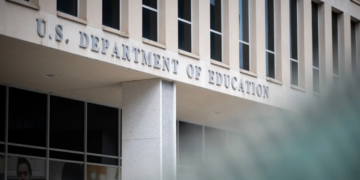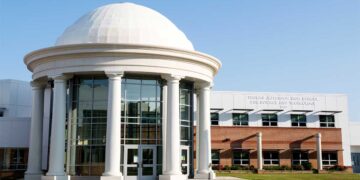Feb 9, 2025 Story by: Editor
Twice a week, researchers at North Carolina A&T State University collect wastewater samples from the campus to test for COVID-19. This effort is led by the Wastewater Surveillance Team, consisting of Professor Dongyang Deng, PhD student Mehdi Lamssali, and the university’s plumber, Paul Mabe.
Professor Deng highlights how this initiative exemplifies the real-world impact of university research.
“Before individuals start showing symptoms, around two to 14 days before, they’re already shedding the SARS-CoV-2 virus into the wastewater,” Deng said.
As a leading research institution in North Carolina, N.C. A&T is engaged in multiple research projects. The university is designated as an R2 institution, indicating “high research activity,” according to the Carnegie Classification of Institutions of Higher Education.
Universities are categorized based on research activity, with R2 positioned between Doctoral Professional Universities and the highly sought-after R1 designation, which signifies “very high research activity.”
Achieving R1 status brings significant advantages, including attracting major donors and securing competitive research grants. N.C. A&T’s Provost, Tonya Smith-Jackson, describes it as amplifying the university’s voice in the research community.
“Sometimes people call it the Matthew effect,” Smith-Jackson said. “Where because you’re in this classification, you tend to be heard, you tend to be perceived to be more credible, people pay attention.”
The Matthew Effect refers to the phenomenon where institutions with advantages continue to accumulate more, while those without struggle to keep up.
R1 institutions receive funding that helps improve research infrastructure and faculty recruitment, leading to groundbreaking research. This, in turn, attracts additional high-value grants and donations, further reinforcing their standing.
To illustrate this effect, Smith-Jackson points to North Carolina’s Research Triangle, home to the state’s only R1 universities—Duke, N.C. State, and UNC-Chapel Hill. Located between these institutions is Research Triangle Park, the largest research park in the United States.
“It’s like a magnet being an R1,” Smith-Jackson said. “It just draws people in because they too want to take advantage of that space. Because it signals that innovation is a value.”
The Road to R1 and Systemic Challenges
N.C. A&T aims to achieve R1 status by the end of the decade. However, this goal is particularly challenging as no Historically Black Colleges and Universities (HBCUs) currently hold the designation.
Howard University briefly attained R1 status in 2000 but was reclassified as R2 when Carnegie adjusted its classification formula in 2005. Currently, 11 HBCUs, including N.C. A&T, hold R2 status.
Despite this classification, Endowed Biology Professor Joseph Graves argues that N.C. A&T has long been operating at an R1 level.
“So, if you rank the UNC system campuses and the research output… We’re number three of the entire system,” Graves said.
This year alone, N.C. A&T secured a record $147.4 million in research funding.
Carnegie’s Executive Director of Classification Systems, Mushtaq Gunja, acknowledges that some R2 universities, including N.C. A&T, conduct research on par with R1 institutions.
“There are HBCUs in this country, including N.C. A&T, that is doing incredible amounts of research,” Gunja said. “And I think that we have not traditionally recognized all of the institutions in the country that I think might be doing very high amounts of research.”
N.C. A&T’s research efforts have had an estimated $157 million impact on North Carolina’s economy, with its overall economic contribution reaching $2.4 billion.
The Impact of Historic Underfunding
Despite its contributions, N.C. A&T has faced significant funding disparities. A recent report from the Department of Education revealed that land-grant HBCUs have been underfunded by over $12 billion in the past 30 years.
In North Carolina alone, N.C. A&T missed out on approximately $2 billion in funding compared to its land-grant counterpart, N.C. State.
“If you gave me the $2 billion that we are owed by this state,” Graves said. “I could transform the demography of science in this state in a decade, easily.”
Graves, who teaches at both N.C. A&T and N.C. State, observes a stark contrast in research infrastructure between the two institutions.
“N.C. State was given the monies that were outlined for them to be able to compete as a premier land-grant university and we were not,” Graves said. “And so, it’s really that simple. You know, I hate to say it — you get what you pay for.”
This funding gap has impacted N.C. A&T’s ability to attract competitive research grants and top faculty, limiting its capacity to upgrade labs and support researchers.
Moreover, Graves highlights how this financial shortfall affects students.
“We have so few faculty, that I have to teach courses that nobody else in this department can teach,” Graves said. “So, our students by necessity are getting a truncated biology major, because we don’t have the faculty.”
Additionally, the lack of resources makes it difficult for the university to recruit top-tier graduate students.
“We therefore have difficulty attracting top quality graduate students to come to our institution,” Graves said. “Because we have, again, difficulties making sure that they’re funded the entire time they’re here.”
Steps Toward R1 Status
To address these challenges and strengthen its R1 bid, N.C. A&T is launching new doctoral programs, expanding its research staff, and enhancing lab facilities.
Some of this funding comes from the state, with this year’s budget allocating $5 million in nonrecurring funds and $10 million in recurring funds to support the university’s efforts.
“They’re committed to an HBCU that can go forward and continue its work and all the implications that go with that research work,” Smith-Jackson said. “And again, it’s advancing the quality of life and facilitating economic growth.”
If N.C. A&T achieves R1 status, its economic impact is projected to grow to over $3 billion. Smith-Jackson believes this would also foster culturally responsive research, addressing issues such as health and wealth disparities in Black communities.
“The community trusts us in doing research to solve problems or to enhance their quality of life,” Smith-Jackson said. “That kind of trust is not quite there for many other institutions. It is there for HBCUs.”
N.C. A&T is aiming for R1 status by 2028. Meanwhile, Carnegie is considering revisions to its classification system to better reflect modern research activities.
“At its core, what we are really hoping to do is to be able to take a fresh look at whether or not in the research category we are accurately capturing who is a very high research activity institution,” Gunja said.
Carnegie is expected to release details on these potential changes next month. Source: WUNC

















